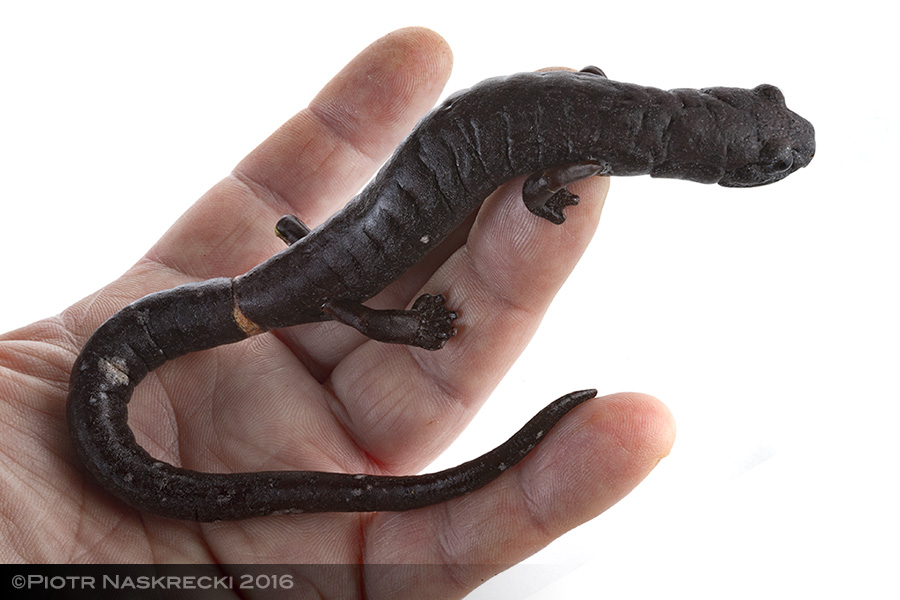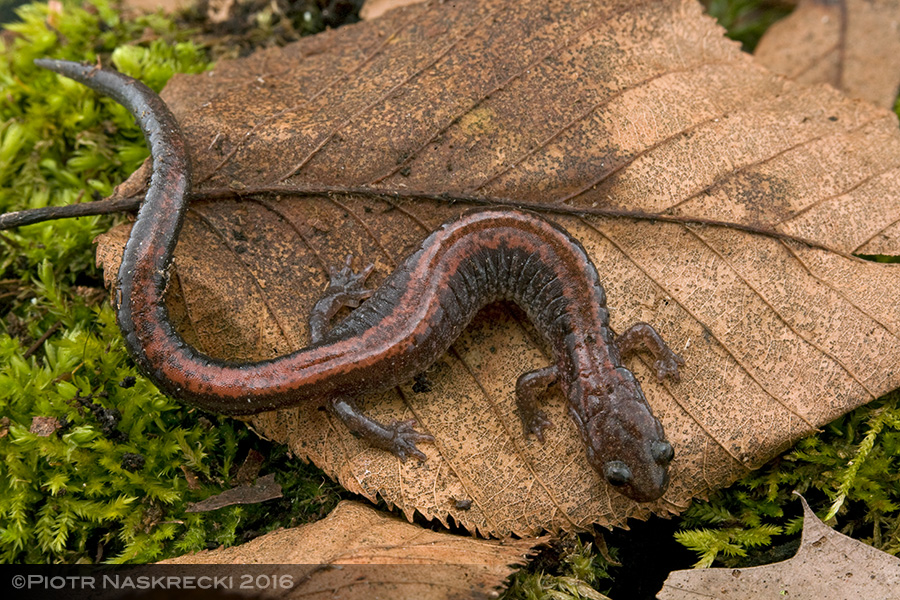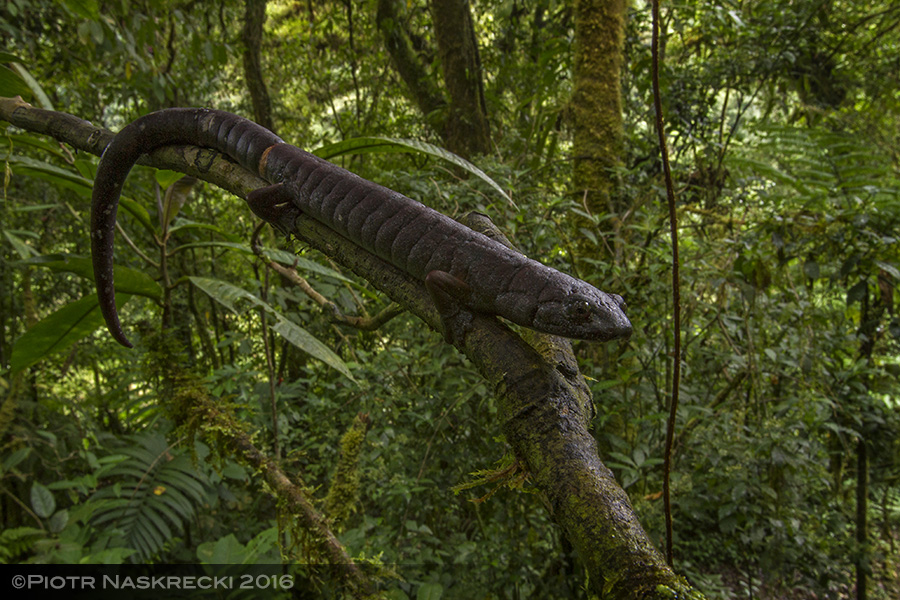
Of all the organs in my body, the one that I would be most reluctant to part with (perhaps with the exception of my eyes) are the lungs. It seems that we need them more than anything else. True, we need all the other bits, but lungs seem particularly useful. Without them the brain stops working in a matter of minutes, the vascular system loses its main reason to exist, and the biochemical processes in pretty much every cell come to a grinding halt. Like the hideous inflatable Santa in front of my neighbor’s house, the complex edifice of the human body would immediately collapse if the air supply were to be shut off. It seems that if you are a land-dwelling vertebrate you better have lungs, or you are not going to last very long. And yet, defying common sense, there is a group of terrestrial animals that got rid of their lungs altogether, and in doing so have become widely successful, outcompeting their lunged relatives in both the number of species and their collective biomass. They are the lungless salamanders of the family Plethodontidae.

I thought of them last month, when freakishly warm weather in Boston forced me to clean up the accumulation of dog poop from the front lawn, which in any other year the snow would have mercifully covered up until spring. The unseasonal warmth also woke up a multitude of creatures that should have been fast asleep, including a couple of Redback salamanders (Plethodon cinereus), which I found under a wooden plank in the garden. Despite the ice crystals glistening in the half-frozen soil, they were surprisingly agile. “Agile” is of course a relative term, especially when talking about an animal whose metabolism is entirely dependent on oxygen passively permeating the skin. Nearly 100% of the oxygen intake and excretion of the carbon dioxide takes place on the surface of the skin of these salamanders, with the throat (buccopahryngeal cavity) accounting for an additional, small proportion of the gas exchange (perhaps for this reason lungless salamanders still retain well-developed nostrils.) Clearly, animals that are incapable of taking active breaths, and thus accelerating or decelerating gas exchange at will, cannot be marathon runners, or runners of any kind. And somehow, by employing various degrees of toxicity and the ability to subsist on low-nutrition diet of springtails and mites, lungless salamanders have managed to become the dominant family of amphibians of the Western hemisphere. Nearly 400 species have already been described and new ones are being discovered every year in both the cool, temperate forests of North America, and in the rainforest canopy of the Neotropics. In some places their numbers are staggering. A recent analysis of the population of the Southern Redneck salamander (P. serratus) of the Ozark Highlands in Missouri put their numbers at 1.88 billion (!) individuals, with the biomass equivalent to that of most whitetail deer in that region – that’s 1,400,000 kg (3,086,471 lb) of amphibian flesh.

Although all members of the family Plethodontidae are entirely lungless, their ancestors were not. What prompted the loss is still a mystery, and two competing theories, neither particularly compelling, try to explain it. According to the older of the two, lungless salamanders originated from a lineage that inhabited cold, fast flowing and well-oxygenated streams of the Cretaceous Appalachia (lungless salamanders still dominate the amphibian fauna of that region). The loss of lungs made them less buoyant and thus more capable of maintaining their position at the bottom of the stream while hunting for prey. But some researchers pointed out the lack of geological evidence for cold, upland environments in the Mesozoic Appalachia. Instead, they argue, lungless salamanders come from oxygen-poor tropical waters, where highly humid terrestrial environment proved to be a better alternative. Once on land, dense vegetation exerted adaptive pressure to evolve small, narrow heads, which in turn prevented the animals from filling their lungs effectively, and leading to the reliance on respiration through the skin. If this sounds sketchy to you, you are not alone. Most herpetologists today lean towards the first explanation, with the added argument that the loss of lungs happened early on in the larval development of the aquatic ancestors of the plethodontids. But the truth is, nobody really knows.

What is not in question is the fact that lungless salamanders rule the forests of North, Central, and parts of South America. Larger species tend to be ground-dwelling, whereas smaller ones live high in the canopy. The arboreal salamanders have evolved a number of cool adaptations to such a lifestyle. The Central American genus Bolitoglossa is famous for its lack of distinct fingers. Instead, these salamanders have pad-like feet that help them move on smooth, wet surfaces of rainforest trees. And although feet in all species of Bolitoglossa look similar, they are the result of two very different evolutionary processes. In smaller species, such as the colorful (and toxic) B. mexicana, the digit-less foot is the result of paedomorphosis – a developmental mechanism during which juvenile characters are retained in adult, reproductive animals. In other words, they have baby feet, and they rely on simple surface adhesion to cling to leaves and branches.
Larger species, such as the Costa Rican B. robusta, also have pad-like feet, but underneath the webbing sit fully developed digits and a complex musculature. The central part of the foot can be lifted, thus creating suction, a mechanism similar to that used by marine cephalopods. But wait, there is more. In addition to having suction cups for feet, this salamander has a prehensile, chameleon-like tail, which it uses to save itself from falling off trees. When I first saw one of these animals a few years ago pull this trick high in the branches in Tapanti National Park, I thought I was hallucinating. And the similarity to chameleons does not end there – just like those reptiles, lungless salamanders sport a long, projectile tongue (in one species the tongue is 80% as long as the body, and salamanders are pretty long animals!) They can eject it with an amazing speed, a mere 117 ms, to catch fast moving prey. And this ballistic tongue projection is an order of magnitude more powerful than that of any muscle in any other living vertebrate species.
All this to say that the next time you find a small, curled up salamander under a rock, look at it with a little more respect. This ancient animal can pull off tricks that would put many Marvel Comics characters to shame. Without taking a breath. Ever.

A really cool sequence of a lungless salamander (Hydromantes) using its projectile tongue (BBC).

Thanks in support of sharing such a pleasant idea, article is good, thats why i
have read it entirely
Play free slots, bingo, poker and more at GSN.
100% up to £300 + 30 bonus spins on selected games.
The Southern Redneck salamander? Interesting…
Hi Piotr
Unfortunately, Australia is one of the few land masses that has no salamanders at all–native or introduced. I have always missed them!
D
Fascinating. Back in the early 1980s, I remember finding two lungless slender salamanders (Batrachoseps sp.) under a rock in the tiny patch of long-untended garden in front of our apartment building — smack in the middle of very urban Los Angeles. I couldn’t believe such a delicate-looking amphibian was living in such a fragmented and tiny bit of habitat. On the other hand, with the smog we had in those days, maybe it was an advantage not to have lungs!
Learned some good stuff about Plethodontidae, Piotr.
You did leave me wondering about the nutritional content of springtails and mites, though. Pretty low on a per unit basis, no doubt, but generally, too?
James, from what I could gather, mites and collembolans are considered nutritionally poor (for salamanders) because of the ratio of energy expended per individual capture to the caloric value of the prey. A shrew would not be able to subsist on the diet of springtails but something with very low metabolism, such as a salamander, can. Size ratio also matters – a springtail is an awesome piece of prey for a Pyramica but not for a starling.
Thanks.
By the way, Perhaps you’ve not heard about the demise of Pyramica – Polyphyletic and all swallowed up (in synonymy) by Strumigenys. A big nutritional boost for the latter. ;)
Amazing – never knew about these lung less vertebrates. I wonder if the lungs have disappeared completely or are they vestigial? Presumably they can put that lung space to good use?! Big hearts?☺
Interesting article, I was lucky to find a Bolitoglossa striatula in some bushes in Northern Costa Rica a while back. I had no idea that they were lungless or that such a thing even existed.
Hi Piotr:
Loved this post on lungless salamanders! I have always loved studying them here in Arkansas mountains. Looking forward to meeting you in person at BugShot 2016 in Austin, TX. Can’t wait!
Blue skies,
Rob
Henry W. Robison, Ph.D.